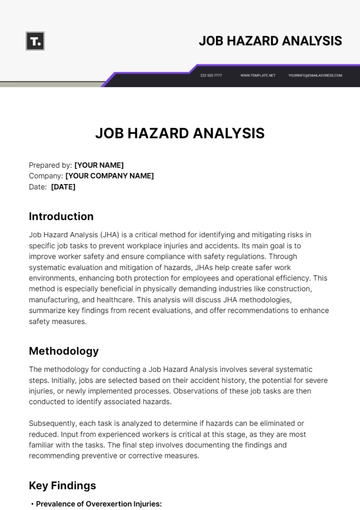Free Financial Risk Analysis Feasibility Study

Executive Summary
This Financial Risk Analysis Feasibility Study provides a comprehensive evaluation of our proposed project to develop and launch a software solution tailored for small to medium-sized enterprises (SMEs). The main objectives of this study were to assess the market viability, financial sustainability, and risk factors associated with the project, as well as to ensure compliance with relevant regulations.
Key Findings
Market Viability: The market analysis revealed a strong demand for integrated business solutions among SMEs, with a trend towards digitalization and remote work compatibility. Despite the competitive landscape, there is a significant opportunity for market penetration, particularly due to our product's focus on customization and user experience.
Financial Projections: Our financial analysis indicates a promising financial outlook with robust revenue growth and positive cash flow expected within the first three years. Initial development and marketing costs are substantial but manageable, leading to a sustainable financial model in the long run.
Risk Assessment: Risks identified include market competition, credit risk, liquidity risk, and operational risk. However, with proper mitigation strategies like diversifying product offerings, maintaining strict credit control, and investing in IT infrastructure, these risks are effectively manageable.
Regulatory Compliance: Compliance with various U.S. regulations such as GDPR, CCPA, FINRA, SOX, PCI DSS, FISMA, and HIPAA is crucial. Our strategy includes ongoing compliance monitoring and regular updates to our practices to align with regulatory changes.
SWOT Analysis: The strengths of the project lie in its innovative approach and skilled team, while weaknesses include new market entry challenges and initial financial constraints. Opportunities for growth are significant due to the expanding market and potential for strategic partnerships, though threats from rapid technological changes and economic downturns exist.
In conclusion, the study supports the viability and potential success of the project. It is recommended to proceed with the development and launch, focusing on strong marketing efforts, continuous product innovation, stringent risk management, and rigorous regulatory compliance. This project presents an exciting opportunity to establish a significant presence in the SME software market, aligning with our long-term strategic goals.
Introduction
In this Financial Risk Analysis Feasibility Study, we aim to evaluate the viability of our proposed project, focusing primarily on the financial risks and potential rewards. This project represents a significant step in our strategic growth plan, aiming to expand our market presence and enhance our product offerings. The scope of this study encompasses a comprehensive analysis of market trends, financial projections, risk assessment, and regulatory considerations. The purpose is to ensure that our investment decisions are data-driven and align with our long-term organizational objectives, balancing potential risks with expected returns.
Project Overview
Our project involves the development of a new software solution aimed at streamlining business operations for small to medium-sized enterprises (SMEs). This solution will integrate various business functions such as inventory management, customer relationship management, and financial reporting into a single platform.
Goals
To capture a 15% market share in the SME segment within the first three years.
Achieve a net profit margin of 20% by the end of year three.
Establish strong brand recognition as a provider of comprehensive business solutions.
Deliverables
A fully functional software platform with customization options.
Comprehensive user manuals and training modules.
Regular software updates and customer support services.
Timeline
Phase 1 (Months 1-6): Research and Development.
Phase 2 (Months 7-12): Initial development and alpha testing.
Phase 3 (Months 13-18): Beta testing with select clients.
Phase 4 (Months 19-24): Official launch and marketing campaign.
Ongoing: Post-launch support, updates, and continuous improvements.
Key Stakeholders
Internal Teams: Development, Marketing, Sales, Customer Support.
External Parties: Investors, Beta Test Clients, Regulatory Bodies.
End Users: Small to medium-sized enterprises in various sectors.
Market Analysis
This section of our Financial Risk Analysis Feasibility Study is dedicated to a comprehensive market analysis. We aim to understand the current market conditions, trends, and the competitive landscape, as well as to forecast demand, which are crucial for the strategic positioning of our software solution.
Current Market Conditions and Trends
Increasing Demand for Integrated Solutions: There is a growing trend among SMEs to seek all-in-one software solutions that can consolidate various business functions.
Technology Adoption: SMEs are increasingly adopting technology to enhance efficiency, with a significant shift towards cloud-based solutions.
Remote Work Compatibility: The rise of remote work has escalated the need for software that supports remote business operations.
Competitive Landscape
Competitor | Market Share | Strengths | Weaknesses |
Competitor A | 20% | High brand recognition | Higher cost |
Competitor B | 15% | Competitive pricing | Limited customization |
Our Company | (15%) | Customizable solutions | New entrant |
Demand Forecasts
Year | Projected Market Size | Expected Demand | Estimated Revenue |
Year 1 | 500 | 5% | 25 |
Year 2 | 550 | 10% | 55 |
Year 3 | 600 | 15% | 90 |
These tables demonstrate a favorable market opportunity for our software solution. Our focus on customization and SME-specific needs positions us uniquely in the competitive landscape. The projected growth in market size and our anticipated increase in market share underscore the feasibility and potential success of our project.
Financial Analysis
In this crucial section, we delve into the financial viability of our project through a detailed analysis of projected revenues, costs, and cash flow. This financial analysis is vital to assess the project's potential profitability and sustainability over time.
Revenue Projections
Year | Estimated Revenue ($ million) | Annual Growth Rate |
Year 1 | 25 | - |
Year 2 | 55 | 120% |
Year 3 | 90 | 64% |
The revenue projections indicate robust growth in the first three years, with a significant increase in year 2 as market penetration deepens. By year 3, we anticipate a consolidation of market position, reflected in the healthy growth rate. These projections are based on market trends and our competitive strategy.
Cost Analysis
The initial year sees higher development costs, which are expected to decrease over time as the product moves from development to maintenance. Marketing costs will increase as we expand our reach, while operational costs rise steadily with the growth of our customer base and service enhancement.
Cash Flow Analysis
Year | Revenue | Total Costs | Net Cash Flow |
Year 1 | 25 | 18 | 7 |
Year 2 | 55 | 17 | 38 |
Year 3 | 90 | 19 | 71 |
The cash flow analysis shows a positive trajectory, with net cash flow increasing each year. The initial year's positive cash flow demonstrates the project's immediate financial viability. In subsequent years, as revenues rise and costs are managed effectively, the net cash flow substantially improves, indicating the project's long-term financial sustainability. This positive cash flow will be crucial for reinvestment and further growth initiatives.
Risk Analysis
This section of the Financial Risk Analysis Feasibility Study is dedicated to identifying, assessing, and devising strategies to mitigate various risks associated with our project. Understanding and preparing for these risks is critical to ensure the project's success and long-term sustainability.
Risk Type | Likelihood | Impact | Mitigation Strategies |
Market Risk | Moderate | High | Diversify product offerings, continuous market research, adaptive marketing strategies |
Credit Risk | Low | Moderate | Strict credit control policies, thorough creditworthiness assessment of clients |
Liquidity Risk | Low | High | Maintain adequate cash reserves, establish lines of credit, effective cash flow management |
Operational Risk | Moderate | Moderate | Invest in robust IT infrastructure, staff training, develop contingency plans |
Market Risk: There's a moderate likelihood of market risks due to changing consumer preferences and intense competition. The impact could be high if not addressed. Mitigation involves diversifying our product range and staying informed about market trends to adapt our marketing strategy accordingly.
Credit Risk: The likelihood is low, considering our stringent credit control processes. However, any credit default could have a moderate impact. Our mitigation strategy includes conducting thorough assessments of our clients' creditworthiness before extending credit.
Liquidity Risk: Though the likelihood is low due to our conservative financial management, the impact on operations could be high if it occurs. To mitigate this, we will maintain adequate liquidity reserves and establish credit lines for smooth cash flow.
Operational Risk: This risk is moderate, mainly due to potential IT system failures or human errors. The impact is also moderate. Our mitigation strategies include investing in high-quality IT infrastructure, regular staff training, and having comprehensive contingency plans in place.
Regulatory and Compliance Review
In this section, we conduct a thorough review of U.S. regulatory requirements and compliance issues that could significantly impact our project. Understanding and adhering to these regulations is imperative for the lawful and ethical execution of our project.
The nature of our software solution necessitates compliance with several U.S. regulations, primarily focusing on data security, privacy, and financial reporting standards. Key regulatory considerations include:
General Data Protection Regulation (GDPR): Although a European regulation, it applies to any business, including ours, that processes the personal data of individuals in the EU. We must ensure GDPR compliance in our data handling practices.
California Consumer Privacy Act (CCPA): As we operate in the U.S., compliance with CCPA is crucial. This involves transparent data collection practices and allowing California residents to opt-out of their personal data being sold.
Financial Industry Regulatory Authority (FINRA) Compliance: Our software must comply with FINRA regulations if used by clients in the financial sector. This includes ensuring the security and integrity of financial transactions and reporting.
Sarbanes-Oxley Act (SOX) Compliance: For clients using our software for financial reporting, SOX compliance is essential. This includes implementing internal controls and procedures for financial reporting to reduce the risk of corporate fraud.
Payment Card Industry Data Security Standard (PCI DSS): If our software handles credit card transactions, compliance with PCI DSS is mandatory to protect cardholder data and prevent credit card fraud.
Federal Information Security Management Act (FISMA): If our software is used by government agencies or contractors, compliance with FISMA is required to ensure the security of federal information systems.
Health Insurance Portability and Accountability Act (HIPAA): If our software is used in the healthcare sector, HIPAA compliance is necessary for the protection of sensitive patient health information.
Non-compliance could result in legal penalties, financial losses, and reputational damage. Therefore, our strategy includes ongoing compliance monitoring, regular audits, and updates to our software and practices in line with changing regulatory landscapes. This proactive approach ensures not only the legal integrity of our operations but also builds trust with our clients and stakeholders.
SWOT Analysis
This section presents a SWOT Analysis to identify and evaluate our project's Strengths, Weaknesses, Opportunities, and Threats. This analysis is crucial for strategic planning, helping us leverage our strengths and opportunities while addressing our weaknesses and mitigating potential threats.
Strengths | Weaknesses | Opportunities | Threats |
Innovative software solution tailored for SMEs | New entrant in a competitive market | Growing demand for integrated business solutions | Rapid technological changes and innovation by competitors |
Strong focus on user experience and customization | Limited brand recognition initially | Expansion potential in untapped markets | Regulatory changes impacting software development and data management |
Skilled development and marketing team | Initial financial constraints for extensive marketing | Potential for strategic partnerships and collaborations | Economic downturns affecting client spending |
Robust IT infrastructure and support services | Dependence on external funding sources | Increasing trend towards remote work and digitalization | Cybersecurity threats and data breaches |
Conclusion and Recommendations
Our Financial Risk Analysis Feasibility Study reveals that the project to develop and launch our innovative software solution for SMEs is both viable and promising. The growing market demand for integrated business solutions, combined with our product's unique features and our team's expertise, positions us well in the competitive landscape. Financial projections indicate strong revenue growth and positive cash flow, suggesting financial sustainability. While there are risks associated with the project, including market competition and regulatory challenges, these are manageable with our outlined mitigation strategies.
Based on our analysis, we recommend the following:
Proceed with the Project: Given the favorable market outlook and strong financial projections, we should proceed with the development and launch of the software solution.
Focus on Brand Building and Marketing: To overcome our initial weakness of limited brand recognition, invest significantly in marketing and brand-building activities, targeting the SME sector.
Continuous Product Development: Keep innovating and updating the software to stay ahead of technological changes and meet evolving customer needs.
Risk Management: Implement the identified risk mitigation strategies, particularly focusing on market and operational risks. Regularly review and update these strategies to adapt to any changes in the business environment.
Regulatory Compliance: Establish a dedicated team to ensure ongoing compliance with all relevant regulations, particularly in data protection and financial reporting.
Explore Strategic Partnerships: Look for opportunities to form partnerships or collaborations that can enhance market penetration and product offerings.
Financial Management: Continue to monitor and manage financial performance closely, particularly focusing on maintaining positive cash flow and cost management.
Expansion Plans: Once established in the initial market, explore expansion into new markets or sectors to enhance growth potential.
- 100% Customizable, free editor
- Access 1 Million+ Templates, photo’s & graphics
- Download or share as a template
- Click and replace photos, graphics, text, backgrounds
- Resize, crop, AI write & more
- Access advanced editor
Explore financial risks effectively with the Financial Risk Analysis Feasibility Study Template from Template.net. Editable and customizable in our AI Editor tool, this template provides an in-depth framework for analyzing and assessing financial risks in various projects. It's designed to help professionals conduct thorough feasibility studies, ensuring informed decision-making in financial planning and risk management.





























